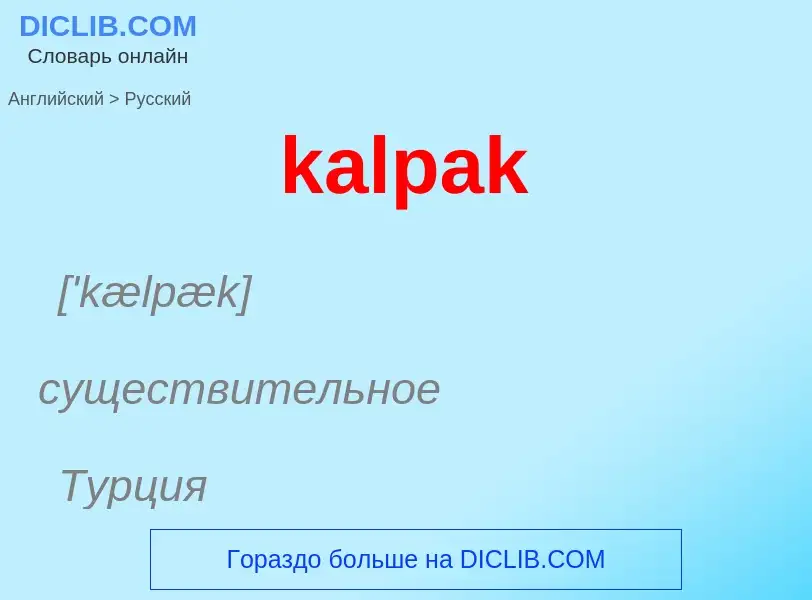Перевод и анализ слов искусственным интеллектом ChatGPT
На этой странице Вы можете получить подробный анализ слова или словосочетания, произведенный с помощью лучшей на сегодняшний день технологии искусственного интеллекта:
- как употребляется слово
- частота употребления
- используется оно чаще в устной или письменной речи
- варианты перевода слова
- примеры употребления (несколько фраз с переводом)
- этимология
kalpak - перевод на русский
['kælpæk]
существительное
Турция
меховой или войлочный колпак
[kɑ:rə'kɑ:lpɑ:k]
прилагательное
общая лексика
каракалпакский
существительное
[kɑ:rə'kɑ:lpɑ:k]
общая лексика
каракалпак
каракалпачка
каракалпакский язык
Википедия

Calpack, kalpak, or qalpaq (Karakalpak: калпак, Turkish: kalpak [kaɫˈpak]; Kazakh: қалпақ, Kyrgyz: калпак, both [qɑlˈpɑq]; Bulgarian: калпак; Greek: καλπάκι (kalpaki); Polish: kołpak; Ukrainian: ковпак, kovpak) is a Turkic high-crowned cap (usually made of felt or sheepskin) worn by Turks, Circassians, Dagestanis, Chechens, Ukrainians, the men of Balkans and throughout Central Asia and the Caucasus.
The kalpak is used to keep the head warm in winter and shade out the sun during summer. There are different kalpaks for different seasons, with kalpaks used in winter being thicker and the ones used in summer being thinner but broader for shading purposes.
There are many styles of kalpak. They usually can be folded flat for keeping or carrying when not being worn. The brim can be turned up all the way around. Sometimes there is a cut in the brim so that a two-pointed peak can be formed. Plain white ones are often reserved for festivals and special occasions. Those intended for everyday use may have a black velvet lining. In the Turkic cultures of central Asia, they have a sharp tapering to resemble a mountain, rather than the cyndrical kalpaks of Turkey.
The word kalpak is etymologically Turkic. According to Armenian lexicographer Sevan Nişanyan, it means felt cap. According to Turkish Turcologist and lexicographer Hasan Eren, it means cap made of leather, fur or fabric. The word kalpak has passed from Turkish to Bulgarian, Serbian, Greek, Hungarian, Persian, Tajik, French, German, Russian and other Slavic languages. The oldest informations about Turkic peoples wearing kalpak is found in ancient Chinese sources. Turkic lexicographer Mahmud al-Kashgari wrote in his Turkic dictionary named Dīwān Lughāt al-Turk, written in the 11th century, that it was very common for Turks to wear a kalpak. Based on this, it would not be wrong to say that kalpak is a Turkic origin cap and the national cap of Turks and later passed on to other peoples.
The word kalpak is also a component of the ethnonym of a Turkic group of uncertain relation: the "Karakalpak" (literally "black kalpak" in the Karakalpak language).
In Russian, Persian and Polish, the word is also used for hubcap (for a car wheel's hub; see also the Wiktionary entry hubcap).



![Kyrgyz]] [[Manaschi]] wears a white kalpak for a special occasion Kyrgyz]] [[Manaschi]] wears a white kalpak for a special occasion](https://commons.wikimedia.org/wiki/Special:FilePath/Kyrgyz Manaschi, Karakol.jpg?width=200)
![[[Atatürk]] wearing a Turkish-style kalpak [[Atatürk]] wearing a Turkish-style kalpak](https://commons.wikimedia.org/wiki/Special:FilePath/Müşir Gazi Mustafa Kemal Paşa, Balıkesir, 1923.png?width=200)
![Vereshchagin]] Vereshchagin]]](https://commons.wikimedia.org/wiki/Special:FilePath/Wassilij Wassiljewitsch Wereschtschagin 001.jpg?width=200)
![A frame of traditional Karakalpak [[yurt]] or ''qara u'y'' A frame of traditional Karakalpak [[yurt]] or ''qara u'y''](https://commons.wikimedia.org/wiki/Special:FilePath/Armature dune yourte (Khorezm, Ouzbékistan) (6859416536).jpg?width=200)
